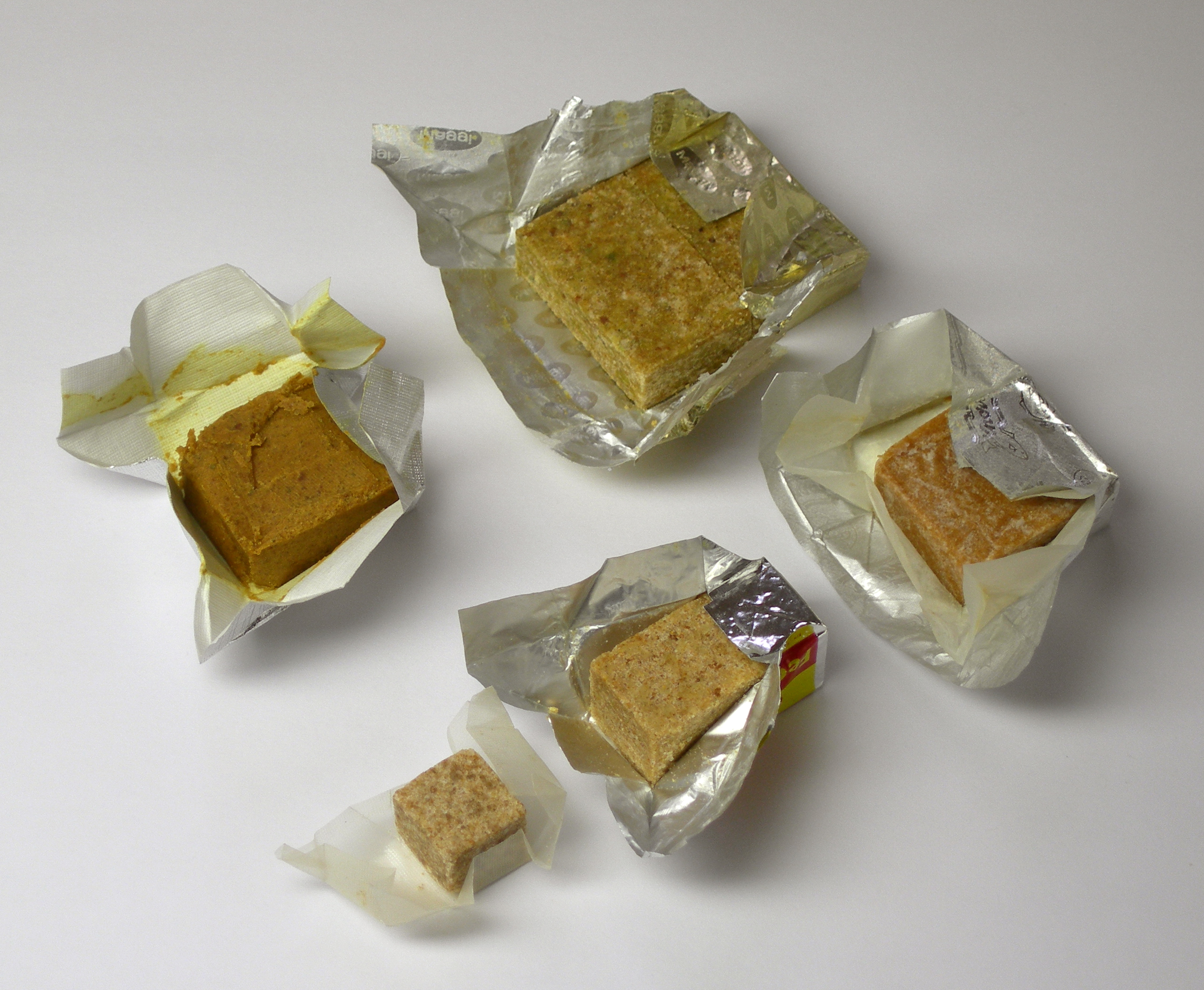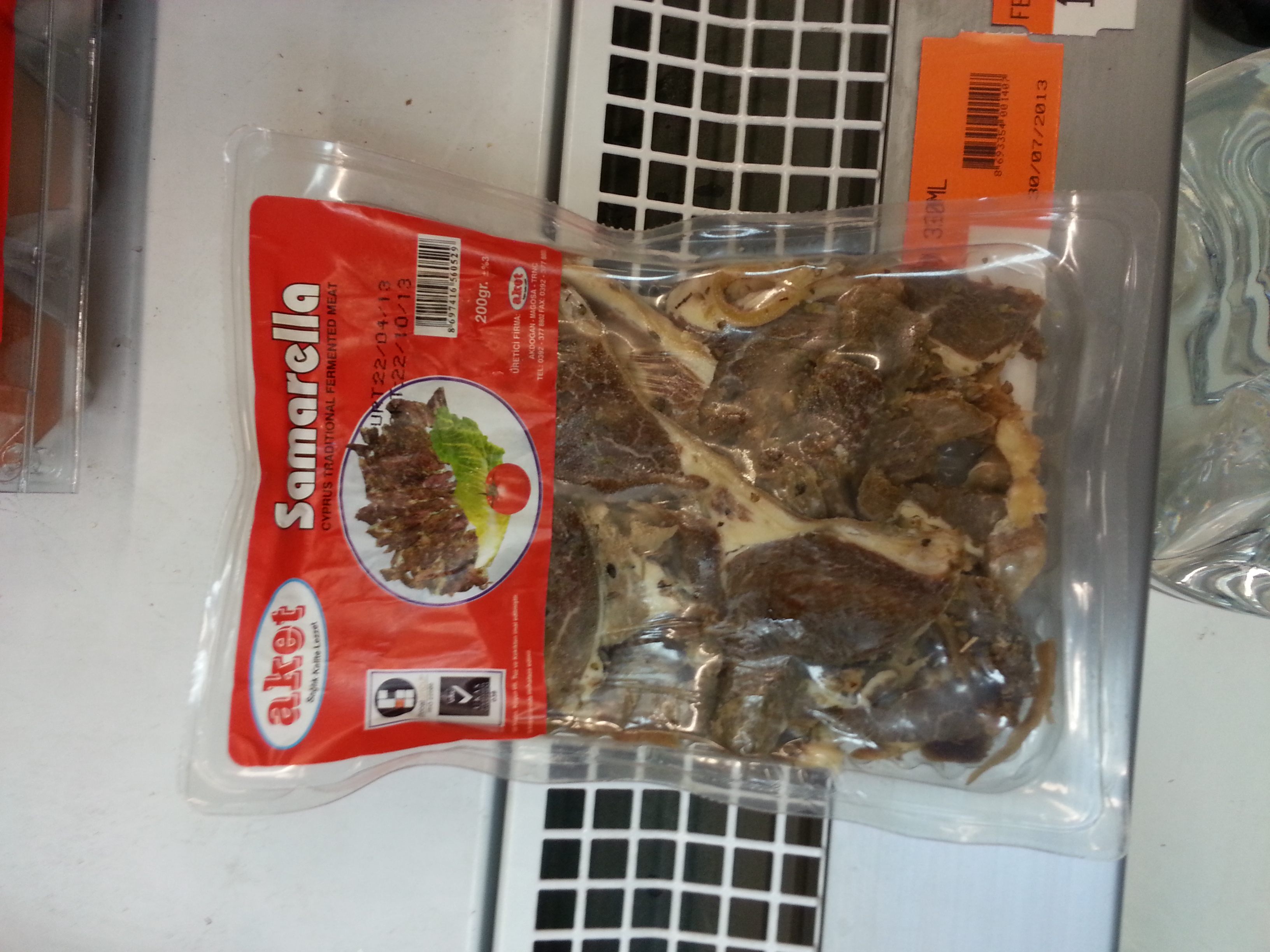|
Tsamarella
Tsamarella ( gr, τσαμαρέλλα, tr, samarella) is a traditional food and one of Cyprus' main lunch meats which is common in both Greek Cypriot and Turkish Cypriot communities. Preparation It consists usually of goat's meat (the whole animal without its bones) that is salted and cured for preservation. The process of preparation traditionally involves drying in the sun for few days. After that, the meat was placed in boiled water and it was filled with condiment (usually oregano) and then producers put it again in the sun for one more day. Tsamarella is soft, it has salty taste and it is served with alcoholic beverages (wine, zivania etc.) as a meze. Historical facts Like the vast majority of Cyprus' dried meats ( lountza, loukaniko, apohtin, zalatina etc.), tsamarella is a traditional product of Marathasa Valley, Pitsilia and Pafos' agricultural areas. Moreover, in the past it was placed in special wooden lockers and it was used as a way to maintain food. See also ... [...More Info...] [...Related Items...] OR: [Wikipedia] [Google] [Baidu] |
Traditional Food
Traditional foods are foods and dishes that are passed on through generations or which have been consumed for many generations. Traditional foods and dishes are traditional in nature, and may have a historic precedent in a national dish, regional cuisine or local cuisine. Traditional foods and beverages may be produced as homemade, by restaurants and small manufacturers, and by large food processing plant facilities. Some traditional foods have geographical indications and traditional specialties in the European Union designations per European Union schemes of geographical indications and traditional specialties: Protected designation of origin (PDO), Protected geographical indication (PGI) and Traditional specialties guaranteed (TSG). These standards serve to promote and protect names of quality agricultural products and foodstuffs. This article also includes information about traditional beverages. Difference between traditional and typical Although it is common for them ... [...More Info...] [...Related Items...] OR: [Wikipedia] [Google] [Baidu] |
List Of Goat Dishes
This is a list of notable goat dishes, which use goat meat as a primary ingredient. Goat meat is the meat of the domestic goat ''(Capra aegagrus hircus)''. It is often called chevon or mutton when the meat comes from adults, and cabrito, capretto, or kid when from young animals. Worldwide, goat meat is less widely consumed than pork, beef, and poultry. Goat dishes Curry dishes * * * gosht * * * * Mutton balti * Meat pies * Mutton pasty Rice dishes Kabsa can be made with goat meat and wild vegetables such as asparagus. This may be related to the origin of paella. * Salads * Vietnamese citrus cured goat salad Soups and stews * * Chui jhal – A stew from Khulna, Bangladesh Miscellaneous * Apohtin * Argentine mutton berbeque * Bhutan – A spicy dish prepared with goat tripe. A speciality in Nepal. * Bocksbraten, a specialty in the surroundings of Bamberg in Germany, which is usually offered for the church consecration (Kirchweih). * Boodog, a dis ... [...More Info...] [...Related Items...] OR: [Wikipedia] [Google] [Baidu] |
Apohtin
Apohtin or apohti ( el, απόχτιν) is a traditional Cypriot dried food made by salted goat meat. History Apohtin's roots are traced during the Byzantine period as various texts refer to the preparation of meat (goat meat, beef, pork etc.) that was salted and then dried in the sun. Preparation In order to prepare apohtin, the animal is opened in the middle. Its head, intestines and tallow are removed. Then the meat is washed, salted and left (in a state to protect it from threats able to harm its quality, such as insects), to the sun for a period of three to four weeks in order to get dry. After that period, meat is sliced into small pieces, washed again and becomes available for any type of cooking. In Cyprus apohtin is a common meze that is served with alcoholic beverages (wine, zivania etc.). A food similar to apohtin is noted in Santorini under the same name. That kind of apohti refers to a food based in pork tenderloin that is salted and dried in the sun. Also, the p ... [...More Info...] [...Related Items...] OR: [Wikipedia] [Google] [Baidu] |
List Of Dried Foods
This is a list of dried foods. Food drying is a method of food preservation that works by removing water from the food, which inhibits the growth of bacteria and has been practiced worldwide since ancient times to preserve food. Where or when dehydration as a food preservation technique was invented has been lost to time, but the earliest known practice of food drying is 12,000 BC by inhabitants of the modern Middle East and Asia."Historical Origins of Food Preservation". Accessed June 2011. Dried foods Processed foods B  ...
...
[...More Info...] [...Related Items...] OR: [Wikipedia] [Google] [Baidu] |
Dried Meat
Dried meat is a feature of many cuisines around the world. Examples include: *Kulen Slanina Pečenica *Aliya, sun-dried meat from Kenya * Bakkwa or rougan, Chinese salty-sweet dried meat sheets. * Biltong, a cured meat that originated in Southern Africa. * ''Bògoǫ'', a dried and smoked meat, often caribou, of the Dené people of northern Canada. * Borts, air-dried strips of horse or cow meat used as traveling food or to last the winter in Mongolia. Often ground into powder and mixed with water to create soup. * Bresaola, air-dried salted beef originally from the Valtellina valley in northern Italy. * Brési, made in the canton of Jura and in Jura Bernois in Switzerland and in the department of Doubs in France. * Bündnerfleisch, air-dried meat from Kanton Graubünden in Switzerland. * Carne-de-sol, sun-dried salt beef from Brazil. * Carne seca, air-dried meat from Mexico. * Cecina, lightly smoked, dried, and salted meat from northwestern Spain (Asturias, León, Cantabria), ... [...More Info...] [...Related Items...] OR: [Wikipedia] [Google] [Baidu] |
Jerky
Jerky is lean trimmed meat cut into strips and dried (dehydrated) to prevent spoilage. Normally, this drying includes the addition of salt to prevent bacteria growth before the meat has finished the dehydrating process. The word "jerky" derives from the Quechua word '' ch'arki'' which means "dried, salted meat".Teofilo Laime Ajacopa, Diccionario Bilingüe Iskay simipi yuyayk'ancha, La Paz, 2007 (Quechua-Spanish dictionary) All that is needed to produce basic "jerky" is a low-temperature drying method, and salt to inhibit bacterial growth. Modern manufactured jerky is often marinated, prepared with a seasoned spice rub or liquid, or smoked with low heat (usually under 70 °C/160 °F). Store-bought jerky commonly includes sweeteners such as brown sugar. Jerky is ready-to-eat, needs no additional preparation and can be stored for months without refrigeration. To ensure maximum shelf-life, a proper protein-to-moisture content is required in the final cured product. Man ... [...More Info...] [...Related Items...] OR: [Wikipedia] [Google] [Baidu] |
Paphos District
Paphos District ( el, Επαρχία Πάφου, tr, Baf kazası) is one of the six districts of Cyprus and it is situated in the western part of Cyprus. Its main town and Capital (political), capital is Paphos. The entire district is controlled by the internationally recognized government of Cyprus. There are four municipalities in Paphos District: Paphos, Yeroskipou, Peyia, and Polis, Cyprus, Polis Chrysochous. The area of the district is 1,396 km2, which constitutes the 15.1% of the total area of the island, and the population in 2011 was 90,295. Its coastal area is characterized by gulfs and coves, capes and points, beaches and tiny isles. The district can be divided into three morphological regions: the coastal plain, lying mainly below 200 metres, the hilly area extending from plain up to the igneous rocks of Paphos forest and the mountainous region, lying mainly on the igneous rocks of the Paphos forest. North-west of the District is the Akamas peninsula which contai ... [...More Info...] [...Related Items...] OR: [Wikipedia] [Google] [Baidu] |
Pitsilia
Pitsilia ( el, Πιτσιλιά) is an agricultural region in Cyprus, with total area of , in a mountainous area of rocky land on very steep slopes that have been used mainly for grazing goats and sheep and for producing small amounts of cereals, wine and grapes. The region complemented by eastern, north and south eastern part of the Troodos Mountains at elevations between and includes villages from the districts of Limassol and Nicosia. The region includes four of the biggest Church of Cyprus, which is registered in the list of World Heritage Sites by UNESCO. This is the church of the Transfiguration in the village Palaichori Oreinis the Cross of Agiasmati in Platanistasa, the Holy Cross in Pelentri and Lady Araka in Lagoudera. Agricultural regions History Towards the end of the 4th century, Christianity adopted as obligatory religion in Roman Empire. In Cyprus some groups, exploiting these events, for personal benefits or revenge, started to use violence against those who d ... [...More Info...] [...Related Items...] OR: [Wikipedia] [Google] [Baidu] |
Marathasa Valley
Marathassa Valley ( el, Κοιλάδα Μαραθάσας) is a beautiful and fertile valley in the Troödos Mountains of Cyprus. It takes its name from the plant ''Marathos'' (Greek: ''Μάραθος''), a type of fennel which grows in the area. The area is known for its splendid cherries. The valley is about a 65 km drive from Limassol. It is to the north of Mount Olympus and it extends into the administrative territory of both Nicosia and Limassol district. It is the highest inhabited valley on the island home to a total of 12 villages, including Prodromos, Lemythou, Tris Elies, Kalopanayiotis and Moutoullas. It is home to Trooditissa and Kykkos Kykkos Monastery ( el, Ιερά Μονή Κύκκου or [] for short, tr, Cikko Manastırı), which lies 20 km west of Pedoulas, is one of the wealthiest and best-known monastery, monasteries in Cyprus. The Holy Monastery of the Virgin of ... monasteries. Valleys of Cyprus {{Cyprus-geo-stub ... [...More Info...] [...Related Items...] OR: [Wikipedia] [Google] [Baidu] |
Loukaniko
Loukaniko (Greek: λουκάνικο) is a type of Greek sausage made from pork or lamb and typically flavored with orange peel, fennel seed, and various other dried herbs and seeds, and sometimes smoked over aromatic woods. They are also often flavored with greens, especially leeks. Loukaniko is often served as a mezze, sliced and fried, sometimes with saganaki. It is also cooked into a variety of dishes. The name 'loukaniko' is derived from ancient Roman cuisine's ''lucanica'' (from Lucania region of Southern Italy) and has been used in Greece since at least the 4th century. Andrew Dalby, ''Siren Feasts'', 1996, p. 181 See also *Lucanica or ''luganega'', an Italian sausage with a related name *Lukanka, a Bulgarian sausage with a related name *Longaniza, any of a variety of sausages from Spain, Latin America, and the Philippines with a related name *Soujouk, a spicy, dry, lean sausage found in from the Balkans and Middle East *List of smoked foods This is a list of smoked ... [...More Info...] [...Related Items...] OR: [Wikipedia] [Google] [Baidu] |



.jpg)